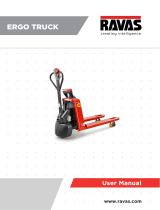
10
Warning
It is strictly forbidden to turn the accelerator knob fastly to speed up the stacker abruptly
during goods transportation.
Move the control handle to division A or division C as indicated in Fig.II and press the rise/lowering button
on th control handle to see if the lifting and lowering of the fork is normal. Then turn the control handle to
division B as indicated in Fig. II, slowly start the truck and press the handle to the horizontal position to check
that whether the truck can travel and brake normally.
Move the control handle to division B as indicated in Fig.II, press the emergency reverse button on top of
the control handle to ckeck that whether the truck can travel backward normally.
After the above check, if there is no failure in the truck, it can be put into operation; if there is some failure,
please repair it at once. It is prohibited to use trucks with problems.
5.2 In operation:
5.2.1Accelerator knob: The accelerator knob is used for controlling traveling direction and speed of the stacker.
When it is for the traveling operation, turn the operation handle to B area indicated in the above diagram.
When the handle is in A or C area, the stacker is in a power-off status, and can not travel. When the operation
handle is in B area and the accelerator knob is turned in one direction, the stacker wil travel in that direction.
While the accelerator is turned in another direction, the stacker will travel in another direction. Meanwhile the
bigger the turning amplitude is, the faster the truck will travel.
Note: A side-magnetic brake is installed on the shaft end of the driving wheel motor and there is a cam and an
inching switch installed on the rotary shaft of the rotary arm. Only when the rotary arm is at 45°±35°(as
indicated in Fig. II), the stacker can be turned on and travel. Larger or less than the angle, the stacker will be
powered-off and braked. In that case, the stacker can lift goods. When lifting goods, the stacker cannot travel.
As indicated in Fig. II, when the operation handle is in division A or division C, the stacker can only lift or lower
but not travel; when the control handle is in division B, the stacker can travel as well as lift or lower. The
operation position of the handle will not be specially described in the following descriptions, i.e. the stacker can
only lift or lower but not travel when the handle is in division A or C and the handle must be in division B when
the stacker is traveling.
5.2.2 As indicated in Fig. II, there is a button on the operation handle which is used for slowing down the
stacker. When this “slow down” button is pressed as well as accelerate knob is turned, the stacker will travel at
a low speed. This state is best suitable for turning a corner, stacking and moving into and out of the shelf while
taking goods. When the “slow down” button is released and the accelerate knob is turned, the stacker will
travel at a normal speed.
5.2.3 Safety height:
The safety lift height for mast is about 1.8m (according to the assembled mast): If the mast is lifted to a height
which is over the safety height, the stacker will slow down to about 3km/h.
5.2.4 Operation of handling and stacking:
Notice
Please check the following items before operation of the stacker:
Ensure no goods falling and goods damaged at loading and unloading area.
Ensure no goods or objects impeding for safety.
The operator shall master the traveling speed according to site condition.The truck shall slow down and
As indicated in Fig. II, pull out the general power supply switch, unlock the electric door lock, and drive the
stacker to the goods pile nearby. (The tip of the fork is 300mm from the goods pile). Press the lowering button,
adjust the height of the fork to a proper position, and insert the fork slowly and as deep as possible into the






















